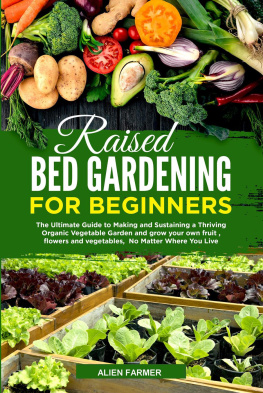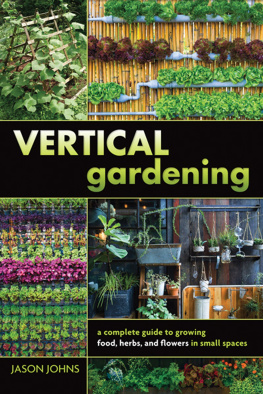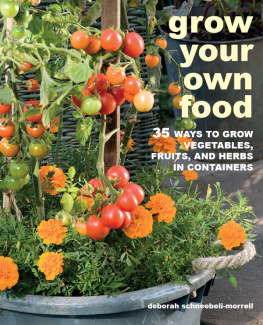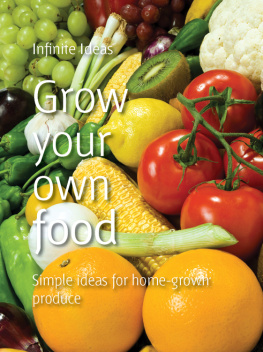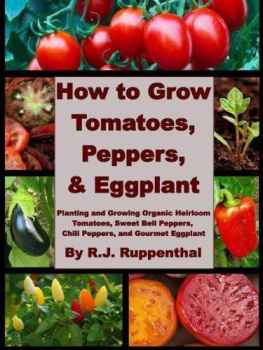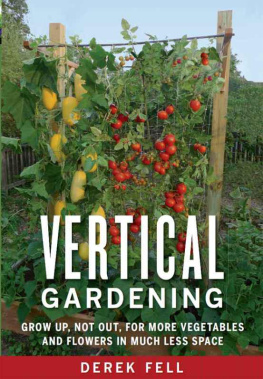VERTICAL
Vegetables & Fruit
RHONDA MASSINGHAM HART
VERTICAL
Vegetables & Fruit
CREATIVE GARDENING TECHNIQUES for GROWING UP IN SMALL SPACES

The mission of Storey Publishing is to serve our customers by
publishing practical information that encourages
personal independence in harmony with the environment.
Edited by Gwen Steege, Carleen Madigan, and Lisa H. Hiley
Art direction by Jessica Armstrong
Book design and text production by Michael Vrana/Black Eye Design Inc.
Illustrations by Kathryn Rathke
Indexed by Christine R. Lindemer, Boston Road Communications
2011 by Rhonda Massingham Hart
All rights reserved. No part of this book may be reproduced without written permission from the publisher, except by a reviewer who may quote brief passages or reproduce illustrations in a review with appropriate credits; nor may any part of this book be reproduced, stored in a retrieval system, or transmitted in any form or by any means electronic, mechanical, photocopying, recording, or other without written permission from the publisher.
The information in this book is true and complete to the best of our knowledge. All recommendations are made without guarantee on the part of the author or Storey Publishing. The author and publisher disclaim any liability in connection with the use of this information.
Storey books are available for special premium and promotional uses and for customized editions. For further information, please call 1-800-793-9396.
Storey Publishing
210 MASS MoCA Way
North Adams, MA 01247
www.storey.com
Printed in the United States by Versa Press
10 9 8 7 6 5 4 3 2 1
LIBRARY OF CONGRESS CATALOGING-IN-PUBLICATION DATA
Hart, Rhonda Massingham, 1959-Vertical
vegetables and fruit / by Rhonda Massingham Hart.
p. cm.
Includes index.
First ed. published as: Trellising.
ISBN 978-1-60342-998-6 (pbk. : alk. paper)
1. Vertical gardening. 2. Trellises. I. Title.
SB463.5.M37 2012
631.546dc23
2011024851
To my beautiful, spectacular, brilliant daughter,
Kaelah, and my handsome, amazing, awesome son,
Lance the absolute joys of my life.
Love you, Mombo
ACKNOWLEDGMENTS
I hope you read this. Its the part of a book in which the grateful author gets to thank all the little people who helped. Im not that deluded. In reality, I barely helped the people who actually did the work. I just wrote the thing. The folks who made it readable, fun to look at, and small enough to carry (not to mention print it, bind it, and haul it off to market) are the ones who should get the real credit.
So heres to the real stars of the show. Publisher Pam Art came up with idea in the first place. We all owe her our thanks. Gwen Steege and Carleen Madigan got the ball rolling. Send them roses. Jessica Richard had the job of herding feral cats in the forms of a writer, business contracts, and other grown-up stuff. There should a medal for that, or at least therapy. Jessica Armstrong wrangled Michel Vrana, the intuitive and gifted graphic designer. They both deserve tremendous credit; someone should take them out to dinner but maybe not together. Ilona Sherratt oversaw the images I sent, along with those that actually made it into the book; chocolates to her. Kathryn Rathke, the illustrator, created the dead-on perfect illustrations youre about to see, on a tight deadline, no less. Champagne perhaps? And Lisa Hiley knitted the whole works together as project editor; roses, dinner, chocolates, and champagne to her!
Contents
PART I
THE WHYS, WHATS, AND HOW-TOS OF MAKING FOOD GROW UP
PART II
VERTICAL ANNUAL VINES
PART III
FINE PERENNIAL FRUITS
Introduction
Weve all seen them. Those gorgeous, elaborate examples of trellised plants beckon, even if only from the pages of the latest garden magazine or website. Images of billowing clouds of climbing roses, obediently outstretched arms of espaliered fruit trees, and cascading waves of wisteria reach from the pages to flirt with our imagination and tug at our envious hearts. Such visions of the gardeners devotion are surely beyond us, the Keepers of the Home Plot, so pressed for time, space, and available resources. Or are they?
True, creating these living works of art takes time and dedication, both things todays backyard gardener often finds in short supply. But the techniques that are used in achieving these glorious results can be put to good use by even the most harried of home growers. The results may be less dramatic with trellised beans or cucumbers than with ornamental flowers, but that depends entirely on ones perspective. Whether you trellis plants for fine art or fine harvests, one of the most appreciable results will be a less harried, less tired, more satisfied gardener!

Using cinder blocks is just one of many resourceful ways to create vertical space in your backyard, an existing garden, or even a deck or balcony.
The principles of trellising garden crops are few and simple. Climbing stems or vines are trained onto upright supports either by means of their own climbing growth habits or by being tied in place. A support or trellis generally consists of standards or a frame, and plant supports. The trellis may be a permanent structure or a seasonal garden fixture.
Creative gardeners with limited space are always experimenting with ways to grow food up, and some of their solutions are nothing short of inspiring. While trellising remains the most common method of vertical crop production, this book offers other ideas for growing food in spaces you may have never thought possible, from potato towers to hanging baskets to wonderful walls of produce and more.
This book is about growing your own food in whatever space you have, whether its a full garden, a strip of an alley, an apartment balcony, or just a windowsill. Its about taking a step toward self-sufficiency and healthy eating. It will show you the best materials to use and how to use them. Basic designs and plans for different types of trellises and which plants are most suited to them are covered. A gallery of some of the best candidates for trellising follows under headings for each specific crop along with suggestions of varieties to try.
A surprising variety of plants can be trained to grow up just about anywhere, anytime. Whereas training perennial vines to a trellis is a gradual process, single-season crops such as tomatoes, squash, and peas yield more immediate results. Best of all are the benefits that a vertical garden offers to both plant and gardener. Freeing up ground space, or making the most of a small plot, is just the beginning. Once youve seen how easy it can be, Im sure youll embrace and enjoy this upward trend and wonder why it took you so long to grow up!
PART I
The Whys, Whats, and How-tos {OF MAKING FOOD GROW UP}
Of all the clever techniques gardeners have devised for squeezing the very most from a patch of dirt, training a climbing or at least pliable vine up a support structure is one of the simplest yet most ingenious. The advantages, in case you need a little convincing that constructing a trellis or an A-frame is worth the effort, are varied and numerous, especially if you fear inadvertently inviting an Audrey II (the uncontrollable, man-eating vine from
Next page

